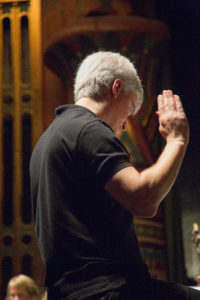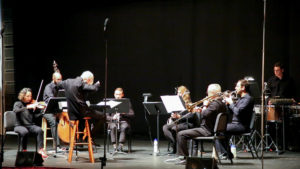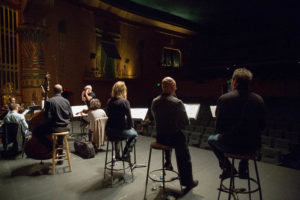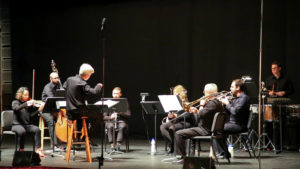
The Boise Philharmonic Chamber Players filled Boise’s Egyptian Theatre last Sunday with Igor Stravinsky’s A Soldier’s Tale. The piece, written by Stravinsky in 1918, combines a small mixed group of musicians with a spoken ensemble. The Soldier’s Tale (L’Histoire du soldat) is not played by the entire Philharmonic, but instead a small, unique group that forms part of the Chamber Group.
 As Boise Philharmonic Music Director Eric Garcia said about the Boise Philharmonic Chamber Players, “By virtue of being chamber music, we have in the Philharmonic a woodwind quintet, a brass quintet, a string quartet and a string trio. So we have those chamber groups. In the 20th Century, composers started writing for small groups of musicians, but mixed, so in this case a violin, bass, clarinet, bassoon, coronet, trombone; and percussion of all things! So in the 20th Century, composers were very adventurous; and really set the groundwork for chamber pieces that mixed various instruments. I think some of our greatest music, in Western music, comes from that kind of outgrowth in the 20th Century”.
As Boise Philharmonic Music Director Eric Garcia said about the Boise Philharmonic Chamber Players, “By virtue of being chamber music, we have in the Philharmonic a woodwind quintet, a brass quintet, a string quartet and a string trio. So we have those chamber groups. In the 20th Century, composers started writing for small groups of musicians, but mixed, so in this case a violin, bass, clarinet, bassoon, coronet, trombone; and percussion of all things! So in the 20th Century, composers were very adventurous; and really set the groundwork for chamber pieces that mixed various instruments. I think some of our greatest music, in Western music, comes from that kind of outgrowth in the 20th Century”.
A Soldier’s Tale tells the story of a soldier who loves his violin. The Devil, in the guise of an old woman, convinces the soldier to sell his violin in return for a book that will reveal the way to great wealth and riches. A Soldier’s Tale follows the life of the soldier and his attempts to find happiness. It is a tale of good and evil and the various ways one can (and cannot) find true happiness. As Stravinsky reportedly said, “It is the first dramatic piece I wrote where the bad guys won – I will probably write like this for the rest of my life…!”. Written during World War I and cobbled together from several Russian folk tales, the spoken dialogue is told by the Narrator (Richard Klautsch), the Soldier (Gordon Reinhart) and the Devil (Linda Kline). And when the Soldier shouts out, “I have it all; and yet I have nothing”, it sums up what it is to sacrifice your soul for worldly goods.
Unlike music of the19th Century, composers such as Stravinsky were interested in experimentation. As a prime example of this, the music starts and stops, sometime to allow straight dialogue, sometimes to play behind it; and other times to take center stage. It also mixes straight tonal combinations with a relatively new type of music for the time, where chords and tonal combinations are not normally combined in a way that was de riguer in the days of Bach, Beethoven and Tchaikovsky. As an innovative piece, many of the combinations are in fact more like the sound of a 1920’s jazz group rather than an orchestra.
As Eric Garcia told The Boise Beat, “When we decided to put together a new Chamber Series, I thought that it would be a good idea to find a chamber work that mixed together a group of instruments that you might not usually see together on stage. There were so many great works in the 20th Century made up of that interesting combination, or setup combinations. For me, that seminal work that really began that trend is this piece, A Soldier’s Tale. I thought it would be a great opportunity for us to collaborate with actors. Certainly, one of the things at the Philharmonic that we want to do is collaborate with other art forms. It’s very important—certainly with such a community as this, where there are so many well-represented art forms. For me, it was just a perfect piece”.
 The Boise Philharmonic Chamber Players performed flawlessly, following Maestro Garcia’s conducting and blending with the spoken words of the Devil, Soldier and Narrator. Chia-Li Ho, the Philharmonic’s Associate Concertmaster, took the lead here to bring the musical sections alive, giving a standout performance of the all-important violin sections. The ensemble’s mastery, moving well between sections of music and spoken word, kept the piece tight and moving along well. Percussionist Matt Grady also stood out, with his percussive accents marking important parts of the music in a way that was very innovative for the time.
The Boise Philharmonic Chamber Players performed flawlessly, following Maestro Garcia’s conducting and blending with the spoken words of the Devil, Soldier and Narrator. Chia-Li Ho, the Philharmonic’s Associate Concertmaster, took the lead here to bring the musical sections alive, giving a standout performance of the all-important violin sections. The ensemble’s mastery, moving well between sections of music and spoken word, kept the piece tight and moving along well. Percussionist Matt Grady also stood out, with his percussive accents marking important parts of the music in a way that was very innovative for the time.
 The Boise Philharmonic Chamber Players also handled the music’s unusual passages, with seemingly random starts and stops and abrupt tonal changes, quite well, keeping the piece flowing. Even in the silent passages, the audience at the Egyptian Theatre seemed enthralled with what was happening on stage. To that end, Linda Kline as the Devil gave a standout performance, with plenty of emotion in her solo passages. A highlight was towards the end, where she essentially spoke as part of her role and also performed almost in a rap/singing style as a counterpoint to the music ensemble’s spirited playing.
The Boise Philharmonic Chamber Players also handled the music’s unusual passages, with seemingly random starts and stops and abrupt tonal changes, quite well, keeping the piece flowing. Even in the silent passages, the audience at the Egyptian Theatre seemed enthralled with what was happening on stage. To that end, Linda Kline as the Devil gave a standout performance, with plenty of emotion in her solo passages. A highlight was towards the end, where she essentially spoke as part of her role and also performed almost in a rap/singing style as a counterpoint to the music ensemble’s spirited playing.
This kind of piece is a great exposure for those who only are familiar with traditional classical music. Indeed, The Soldier’s Tale was an excellent piece for those who want to see where some of the influences came for bands like Yes and Emerson, Lake and Palmer. One can even wonder if it was an influence for the American country folk/bluegrass tune, The Devil Went Down to Georgia. As such, the Boise Philharmonic Chamber Players Series is a worthy introduction to those who are ready to broaden their musical tastes with something non-traditional. To that end, there are more concerts in the Chamber series coming up. Eric Garcia explained, “In this series, the next concert is coming up in February, February 4th. It will be at the Esther Simplot Performing Arts Academy. It will feature our Woodwind Quintet and our Langroise Trio. It’s going to be a very intimate setting”.
Maestro Garcia continued, “We will be holding a reception both before and after the concert. I think this reception’s very important, because it allows people that are coming for the first time to have an hors d’oeuvre, have a glass of wine, just relax and feel comfortable in the space; and then go hear some incredible music and then after the concert, come downstairs to our reception again, have another glass of wine or hors d’oeuvre and meet with the musicians. After a performance, you always have so many questions for the musicians, so for the next two concerts that’s what we’ll be doing. The final concert in the series, in May, will be back here in the Egyptian Theatre. It’s made up of small pieces like this—no actors that time—but an interesting variety of contemporary works. I think it will please everybody”.
 Maestro Garcia is a staunch proponent for getting the listener involved in the enjoyment of music that may be new to them, whether they are a first-time attendee or a long-time concertgoer. He said, “I think that this Chamber Series is certainly a way—the way that it is designed, they’re shorter concerts, each concert is about an hour with no break. There’s always going to be food before and after, so it’s a good way, if you’ve not been to the Philharmonic before, it’s a good way to spend your Sunday afternoon. Free parking, usually lots of parking on a Sunday; and it’s a good way to meet the Philharmonic musicians one-on-one, hear great music, have lovely food and drink and just get to know us. Then, hopefully, you may want to come to a Philharmonic concert after that, because these people are your friends, you feel like you know them fairly well. And for our subscribers, it’s just another way to hear the musicians that they already do know”.
Maestro Garcia is a staunch proponent for getting the listener involved in the enjoyment of music that may be new to them, whether they are a first-time attendee or a long-time concertgoer. He said, “I think that this Chamber Series is certainly a way—the way that it is designed, they’re shorter concerts, each concert is about an hour with no break. There’s always going to be food before and after, so it’s a good way, if you’ve not been to the Philharmonic before, it’s a good way to spend your Sunday afternoon. Free parking, usually lots of parking on a Sunday; and it’s a good way to meet the Philharmonic musicians one-on-one, hear great music, have lovely food and drink and just get to know us. Then, hopefully, you may want to come to a Philharmonic concert after that, because these people are your friends, you feel like you know them fairly well. And for our subscribers, it’s just another way to hear the musicians that they already do know”.
Based on the performance of the Boise Philharmonic Chamber Players with Stravinsky’s A Soldier’s Tale, this inaugural season promises to be an excellent one. Boise is lucky to have such an excellent group of interesting choices, all coming out of their own Boise Philharmonic.
The Boise Philharmonic Chamber Series: Tickets and Information
The Boise Philharmonic: Website
All photos by Anna Meacham, courtesy Anna Meacham











